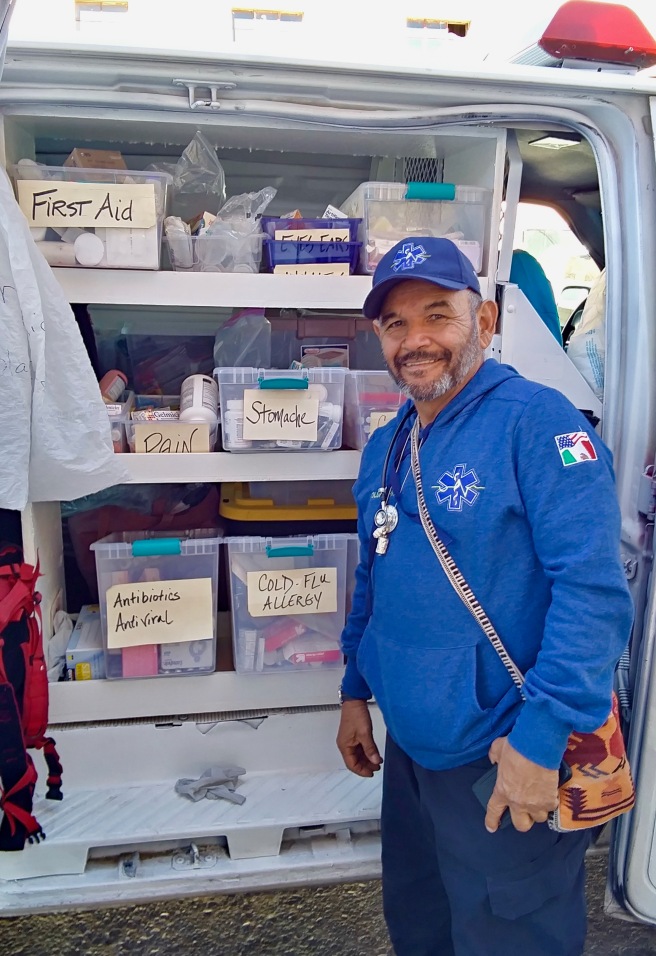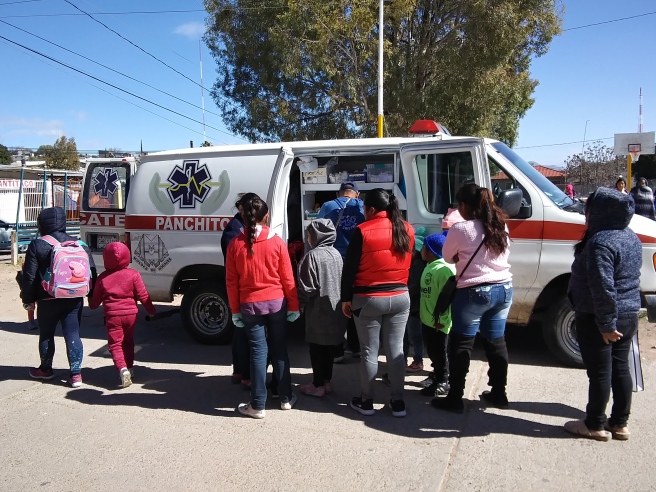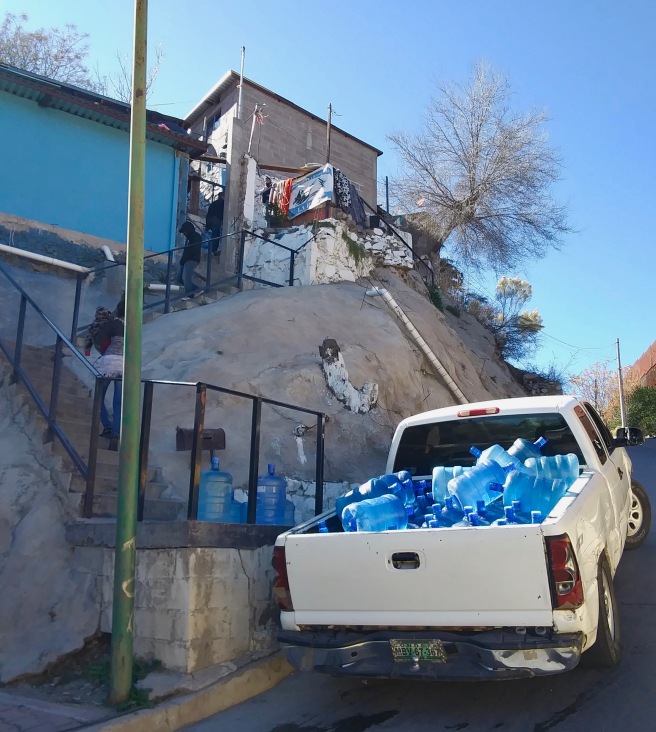My first ride in an ambulance took place in Nogales, Sonora, Mexico. Full-on siren blaring, horn honking, careening through unyielding traffic on narrow streets until we reach the emergency room.
I’m riding with nurse/medic Panchito in his ambulance named Cristina. The cab of the ambulance is littered with antiseptic hand sanitizer, a bottle of vitamins, a blood pressure cuff, bandages and ointments, a nebulizer, and anti-bacterial wet wipes—items I assume Panchito reaches for often. The ambulance is not new, rather it hails from the days before power windows and door locks came standard.
Our first patient/passenger is a pregnant woman who Panchito tells me will deliver her baby in the next few days. We transport her from the outdoor basketball court to the emergency room. Asylum seekers typically hang out at the basketball court during the day because it’s so close to the Comedor, run by Kino Border Initiative. The Comedor serves two free meals every day to immigrants, and distributes clothing and personal care items. Our second patient/passenger is a 24 year-old male asylum seeker whose blood pressure is dangerously high. We rush him to the emergency room as well.
I notice that there’s a well-worn Spanish-English dictionary on Cristina’s dashboard. Having lived in Arizona in the U.S. for 33 years, Panchito’s English is excellent. A group from the Tucson Samaritans comes every Thursday and teaches English at one or two of the shelters, or the basketball court. Panchito used to teach with them, but he kept getting called out with emergency medical calls. As we speed across town in the ambulance, he explains to me again: “This is why I was not able to continue with English classes—always too many interruptions.”
What challenges does Panchito see that the immigrants face in Nogales? 1. They have no money. 2. They’re ignorant of the U.S. immigration process; many think it will be easy to get into the U.S. They have no idea what to expect. This is why I now find myself speeding around with Panchito in his ambulance.
Because I am not an attorney, I cannot give legal advice. But I was able to prepare two simple handouts that explain in Spanish what asylum is, and what to expect if people cross the border and apply for asylum. While I distribute handouts, Panchito communicates the information. He’s fabulous at ad-libbing explanations and examples.
I encourage everyone to speak with a lawyer, at least for an initial consult. Even with a lawyer it’s incredibly difficult to gain asylum; without a lawyer it is nearly impossible. When people ask me how much an immigration attorney costs, I tell them it’s often $5,000 per person, so if they have a family of four, that could be $20,000. However, if you cross the border and end up in detention, your bond could also be as high as $20,000. If any of these people had $20,000 they would not be here.
Our listeners are very appreciative. One man tells me, “You have given me much to think about. I’m going to find a lawyer, but probably I will stay here and work and live. I just don’t have much evidence to prove my asylum case. Why would I risk being separated from my family and imprisoned in the U.S. for six months only to be sent back?”
Back on Panchito’s daily rounds, we drive two women and a child from the hospital to the Juan Bosco shelter, one of four migrant shelters in Nogales. Several women are preparing tortillas for lunch, and we drop off copies of the handouts I’ve prepared. From there we go to La Roca shelter and deliver the remainder of the handouts.
Panchito tells me they’re expecting another visitor on Thursday, this time a lawyer. My visit is well-timed, offering the people some basic information to consider before the lawyer comes. Do they really have a case for asylum? Do they have sufficient evidence? The immigrants can ask specific questions of the lawyer when he comes on Thursday.
Though my days in Colorado are typically spent driving and hanging around with refugees and asylum seekers, this day in Nogales is special. I’m grateful to have been allowed to tag along with Panchito and experience what is an average day for him, helping migrants in ways he’s particularly suited to do. I’m always encouraged and inspired by being with others as we love our immigrant neighbors together.
Voices from the Border works in coordination with the Mexican Non-Profit Panchito y su Cristina—nurse/medic Pancho Olachea Martin—who provides the only free medical care to migrants/asylum seekers and those living in extreme poverty in Nogales, Sonora, Mexico. Please visit the following websites for more information and to donate generously to these excellent ministries:
https://www.mightycause.com/organization/Voices-From-The-Border
facebook.com/voicesfromtheborder
https://www.bordervoicesaz.org/voicesfromtheborder






